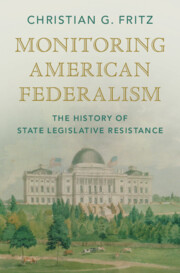Book contents
- Monitoring American Federalism
- Studies in Legal History
- Monitoring American Federalism
- Copyright page
- Dedication
- Contents
- Acknowledgments
- Introduction
- 1 The Riddle of Federalism and the Genesis of Interposition
- 2 Early State Use of Interposition: Testing the Powers of the New National Government
- 3 State Interposition and Debates over the Meaning of the Constitution
- 4 The Virginia and Kentucky Resolutions and Madison’s Report of 1800
- 5 State Interposition during the Jefferson and Madison Presidencies
- 6 State Challenges to the Supreme Court’s Control over Constitutional Interpretation
- 7 The Transformation of Interposition: The Theory of Nullification Emerges
- 8 State Interposition and Nullification on the Path to Secession
- 9 State Interposition during and after the Civil War
- 10 Modern Interposition by States and “Nullification”
- Abbreviations
- Notes
- Selected Short Titles
- Index
4 - The Virginia and Kentucky Resolutions and Madison’s Report of 1800
Published online by Cambridge University Press: 05 January 2023
- Monitoring American Federalism
- Studies in Legal History
- Monitoring American Federalism
- Copyright page
- Dedication
- Contents
- Acknowledgments
- Introduction
- 1 The Riddle of Federalism and the Genesis of Interposition
- 2 Early State Use of Interposition: Testing the Powers of the New National Government
- 3 State Interposition and Debates over the Meaning of the Constitution
- 4 The Virginia and Kentucky Resolutions and Madison’s Report of 1800
- 5 State Interposition during the Jefferson and Madison Presidencies
- 6 State Challenges to the Supreme Court’s Control over Constitutional Interpretation
- 7 The Transformation of Interposition: The Theory of Nullification Emerges
- 8 State Interposition and Nullification on the Path to Secession
- 9 State Interposition during and after the Civil War
- 10 Modern Interposition by States and “Nullification”
- Abbreviations
- Notes
- Selected Short Titles
- Index
Summary
The Virginia and Kentucky Resolutions of 1798 that James Madison and Thomas Jefferson authored as a repudiation of the Federalist-backed Alien and Sedition Acts of 1798 are incorrectly viewed as originating the idea that John C. Calhoun would develop into his theory of nullification, that is, the right of an individual state to veto federal law. Although these interposition resolutions lacked support from other states, their interstate circulation mobilized a grassroots movement that helped elect Jefferson as President in 1800 and overturned Federalist policies. Despite their political success, what Jefferson and Madison meant by language they used in the resolutions burdened the future efforts of states seeking to monitor the governmental balancing of powers and resulted in a deeply troubling political legacy. Madison drew subtle but crucial constitutional distinctions, yet failed to explain what he meant by the theoretical right of the sovereign people to interpose in the last resort (expressed in the Virginia Resolution and in his Report of 1800). Moreover, Jefferson’s statements that unconstitutional laws were null and void seemingly foreshadowed the remedy of nullification.
Keywords
- Type
- Chapter
- Information
- Monitoring American FederalismThe History of State Legislative Resistance, pp. 91 - 128Publisher: Cambridge University PressPrint publication year: 2023

